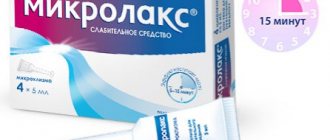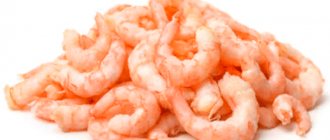Giving an enema to a child means injecting solutions with a therapeutic effect into the rectum using a rubber bulb or an Esmarch mug. The therapeutic procedure is indicated for a baby suffering from constipation. Doing an enema is useful for dysbiosis, painful intestinal colic, and some congenital gastrointestinal pathologies. At the final stage, the child’s intestines are emptied, digestion improves, and appetite returns. Children of any age are wary and hostile to such manipulations. But there are ways to give an enema quickly and completely painlessly.
What is a children's enema and what can it be?
It will not be difficult for experienced parents to give an enema to their child. The procedure leading to bowel movement rarely lasts more than 15 minutes. To carry it out, a certain solution is used, which is filled with a rubber bulb-syringe. Then its tip, lubricated with Vaseline, is carefully inserted into the child’s rectum. Slowly pressing on the base, inject the medicine inside.
Therapeutic children's enemas can be of several types:
- oil The pear is filled with any vegetable or mineral oil. It lubricates the mucous membranes of the colon, ensuring the unhindered passage of feces;
- saline. Enemas are done with solutions of salts, for example, magnesium sulfate. The drugs relax the smooth muscles of the intestine, stimulating the rapid movement of feces towards the anus;
- laxatives. This enema is done with salt dilutions, warm oils, and even plain water. Its purpose is to make bowel movements easier for the baby;
- cleansing. For the procedure, herbal infusions or decoctions and vegetable oils are used, which bind and evacuate deposits accumulated on the intestinal walls.
Sometimes a cleansing enema is performed using the siphon method. Its action is based on the principle of communicating vessels: the intestines are filled several times with liquid, which flows back. You cannot give a high enema to a baby at home. This rather complex medical procedure is performed in a hospital.
A pediatrician or visiting nurse will tell you how to give a newborn a first enema at home. The pediatrician will prescribe the necessary medications and calculate their dosages.
Enema: contraindications
Before giving your child an enema, it is important to make sure that it is not contraindicated for him. You can find out the specifics of the procedure either from a doctor, or use the following list of situations in which the use of an enema is prohibited. So, in what case is it better to refuse an enema and give preference to other methods of treatment?
- The release of blood from the rectum is the main stop signal for procedures involving the use of an enema.
- Tumor formations in the large intestine also exclude the use of an enema.
- Unpleasant sensations in the abdominal cavity or the so-called “board belly”, in which there is strong tension in the abdominal muscles, indicates that the enema should be abandoned. Moreover, it is advisable to go to the hospital as soon as possible. Remember: abdominal pain or lack of stool may indicate the development of serious diseases such as acute appendicitis, intussusception or obstruction. Pay attention to the fact that pain in the abdominal area may indicate diseases such as a strangulated internal hernia, volvulus, or even pneumonia. It is extremely difficult to predict, so consulting a doctor is the best way out of the situation.
- The baby does not want to carry out the manipulation. The child’s emotions during attempts to give an enema are very important: by resisting, he will probably not take a calm position - in this case, there is a high risk of damaging the rectal mucosa.
- You should not turn the procedure of cleansing the intestines with an enema into a regular means of relieving constipation. It is more logical to conduct a comprehensive examination of the baby’s body, which will help identify the causes of constipation. Based on the examination, the doctor will develop a plan to normalize stool through diet and special medications.
The decision on the advisability of performing manipulations using an enema should be made exclusively on an individual basis.
Before you begin the manipulation, you need to make sure that both all the instruments and the child are ready for it.
https://www.youtube.com/watch?v=Jt7N9SBAvGc
The main device in the procedure will be the irrigator. The device, which consists of a tube, a plastic tip and a mug, is suitable for children aged three years and older. If the baby is one year old, how to give an enema? The child will need a syringe with a capacity of up to 200 milliliters.
- It is not recommended to use a cleansing enema on your own, without indications. It is better to consult your doctor once again;
- It is absolutely contraindicated to perform cleansing enemas in the presence of acute inflammatory bowel diseases, rectal prolapse, or intestinal bleeding.
Indications and contraindications for the procedure
A cleansing enema for a child is usually prescribed for food poisoning, intoxication with drugs or household chemicals. It is indicated not for the treatment of chronic constipation, but for the accelerated removal of toxic substances from the body. The less of them are absorbed into the bloodstream, the lower the likelihood of negative consequences of poisoning. You can make a cleansing enema for children with vaseline oil and isotonic sodium chloride solution.
For newborns and infants, procedures are prescribed for rare bowel movements - no more than once a day. They are done for constipation due to the following reasons:
- dysbacteriosis. Until about a year old, the state of a child’s intestinal microflora is unstable. Strains of beneficial bacteria periodically die, and in their place opportunistic representatives of the microbiocenosis multiply;
- deficiency of digestive enzymes. In children under two years of age, the pancreas does not work at full capacity. It does not produce enough digestive enzymes to break down fats, proteins and carbohydrates.
Antiparasitic enemas are also made at home with infusions of tansy or wormwood. But the use of these ineffective procedures is fading away: effective anthelmintic drugs have long been synthesized.
If there are contraindications, enemas are prohibited . They are not prescribed to children suffering from acute appendicitis, ulcerative lesions of the rectum, peritonitis, and intestinal bleeding. Manipulations should not be done if you have hemorrhoids or anal fissures. Microtrauma of the anorectal area is also a contraindication.
Possible harm
In addition to the contraindications for health reasons mentioned above, an enema can harm a completely healthy child or adult if this procedure is abused. Very often, people suffering from constipation avoid complex treatment of the problem, simply giving cleansing enemas from time to time. After this procedure, the problems go away and the person can return to their normal life. The same applies to children. Irresponsible parents who do not want to restore natural processes in their children’s bodies simply periodically cleanse their intestines with a syringe.
The fact is that with regular help, the intestines simply refuse to work on their own, which subsequently provokes a complete stop. It is necessary to sound the alarm even when the baby needs the procedure more than once every two weeks. In this case, the pediatrician will definitely prescribe mild laxatives.
The harm of frequent enemas is also manifested in the leaching of beneficial microflora from the intestines, which can take years to restore. All this affects a person’s general well-being, his immunity and appearance. So before giving their children an enema, parents should think very carefully and weigh the pros and cons.
What solution and in what volume is suitable for a child?
For newborns and infants up to six months, enemas are often done with glycerin, chamomile decoction, and sterilized petroleum jelly. For older children, the list of possible medications is much wider.
Make defecation easier:
- sunflower and linseed oil;
- solutions of soda, sodium chloride and magnesium sulfate (a teaspoon per glass of boiled water);
- infusions of string and calendula - a teaspoon of dry plant material per glass of boiling water.
Soap solution works great for constipation. To prepare it, baby soap is ground on a grater. Add 1/2 teaspoon of powder to 100 ml of warm water. Dissolve it by thoroughly shaking until foam forms.
The optimal water temperature for an enema for a child is considered to be 30-33°C. For siphon manipulations, only cool solutions are used.
The volume of any enema for a child depends on age, and not on the severity of constipation:
- 4 months - 60-70 ml;
- 4-10 months -70-110 ml;
- 10–12 months - 110-180 ml;
- 1–2 years - 0.2 l;
- 2-5 years - 0.3 l;
- 5-10 years - 0.4-0.5 l.
An enema for a newborn should be done with an amount of water of no more than 40 ml (less than two tablespoons). It should be moderately warm, cleared of impurities using a filter. For babies under 2 months of age, any liquids for insertion into the rectum should be used in this volume.
How does an enema help with constipation?
An enema for a child works exactly the same as an enema for an adult. In the fight against constipation, cleansing names are most often used, which allow you to simply remove feces from the intestines along with water. The main indications in childhood are conditions such as flatulence and constipation.
Please note that some other varieties can also be used:
- Hypertensive microenemas are used to provoke independent cleansing of intestinal receptors. To prepare it, a strong saline solution is used, for example, with the most common salt.
- An oil microenema that has a relaxing effect on the walls and muscle structure of the intestines. To combat constipation, the oil should be warm. In this case, olive or sunflower oil is used, or pharmaceutical vaseline can be used.
- Microlax is another type of enema for a child with constipation, which is a viscous solution of sodium citrate, sorbitol solution and other components. The advantage of the product is that it is not addictive and has a positive effect on the child’s body.
In childhood, a cleansing enema is most often performed. How to do this will be discussed below.
How to prepare for the procedure
Doing an enema at home is easy, but not always necessary. The cause of constipation must be established, because it can be caused by a disease that requires completely different treatment. It is advisable to give your baby an enema on your own in case of peristalsis disorders caused by nutritional errors, including breastfeeding, or dysbacteriosis.
The first stage of preparation is to purchase everything you need. Then you should read the step-by-step instructions for performing delicate manipulation. Before giving an enema to an older child (from 3 years old), you need to talk with the little patient . You should tell him about the sensations that he will experience, as well as the purpose of the procedure and the need for it. Then boys and girls will be able to relax and take treatment responsibly.
An enema for dysbacteriosis should be done only as prescribed by a doctor, if drug treatment is ineffective. As a rule, pathology responds well to treatment with prebiotics, probiotics, and symbiotics.
What will you need?
An enema at home for constipation is done in compliance with all the rules of asepsis. The immune system of babies is just developing and is malfunctioning. Therefore, an antiseptic is required to treat medical devices. This can be ethyl alcohol diluted with an equal volume of water, a solution of chlorhexidine, Miramistin, or an alcohol-containing lotion.
It will not be possible to perform an enema without the following devices and medications:
- sterile gauze wipes;
- lining oilcloth;
- means for preparing medicinal solutions;
- medical Vaseline.
For children under 5-7 years old, a regular rubber bulb or syringe is suitable. But for older children it is better to buy an Esmarch mug. Outwardly, it resembles an ordinary heating pad, to which a rubber hose with a plastic tip is attached. Both the syringe and the Esmarch mug must be disinfected in the manner specified in the instructions for use. Typically, medical products are boiled or wiped with alcohol.
Giving an enema to infants under 2 years old will not be difficult if you distract them. A bright toy or teether will help.
Sequencing
How to give an enema to children, the instructions explain the same thing for all ages. First of all, it is necessary to prepare the baby himself for the procedure, if he is already at an age capable of perceiving what is said correctly.
After this you need:
- spread the bed and cover it with oilcloth;
- lay a sheet on top of the film;
- if disposable diapers will be used, simply lay them on the bed;
- after preparing the place, the adult needs to wash the baby and put him on the bed;
- after this, wash your hands thoroughly with soap and put on sterile gloves;
- a syringe that has been boiled in advance must be squeezed so as to completely release the air;
- dip the tip into the prepared water and draw;
- After this, lubricate the tip with cream or oil;
- now you need to put the baby on his side with his knees bent, so that they are pulled up to his stomach;
- With one free hand, you should spread the children’s buttocks and fix them;
- with the second hand, squeeze out the remaining air from the full bulb and, without unclenching, insert the tip into the anal passage;
- The bulb should be inserted first towards the navel, and then parallel to the tailbone for a few centimeters;
- The liquid should be administered slowly;
- after emptying the syringe, its tip is removed from the anus, and the buttocks are immediately clamped tightly;
- After a few minutes, when the child feels the urge to defecate, you need to sit him on the potty.
It is very important to place the potty right next to the bed, since after an enema the baby may not make it to the toilet. As soon as the intestines have emptied, the child should be thoroughly washed, hands should be removed from gloves and washed with soap, and the enema should be washed in soapy water and boiled.
Algorithm for performing a cleansing enema
You need to do a pear enema at home after washing the child with any hygiene product. It is advisable that it does not contain dyes or fragrances that can cause irritation of the rectal mucosa. You need to make sure that the child does not have microdamages in the anorectal area.
Pediatricians strongly recommend taking your temperature during the preparation stage. This is best done using an electronic thermometer, which is inserted into the rectum for 1 minute. At high temperatures, the procedure is strictly prohibited.
Colon cleansing is carried out the same way for children of any age. But giving an enema to an older child is easier. Using a baby bulb on infants may require assistance from a second parent.
For an infant
To properly administer a therapeutic enema to a newborn, you need to use a compact bulb syringe. Some parents practice bowel cleansing with a syringe with the needle removed and a cylinder volume of 50-100 ml. This should not be done. There is a high probability that when the baby moves suddenly, the thin mucous membrane of the rectum is injured.
How to give a one-year-old child a cleansing enema:
- squeeze the base of the pear, dip its tip into oil, solution or infusion;
- release slowly so that no air bubbles enter the housing;
- wipe the tip with a sterile cloth, lubricate it with medical petroleum jelly or glycerin;
- in a supine position, bring the child’s legs together and lift them up;
- With your free hand, spread the buttocks, insert the tip 3 cm inside the rectum;
- slowly squeeze the pear until it is empty;
- remove the tip, remove the remaining solution with a napkin;
- squeeze the child’s buttocks and hold them in this position for 1-2 minutes so that the liquid does not immediately pour back out.
It is better to give a cleansing enema to the baby an hour after feeding . In this case, complete bowel movement will occur along with accumulated gases.
A one-month-old baby is allowed to have an enema no more than once a day. If peristalsis is not restored after 2 procedures, you should seek medical help.
Children after 1 year
The algorithm of the therapeutic procedure for one-year-old children is the same as for newborns.
One of the differences is that manipulations are done with a volume of solution corresponding to the baby’s age. If the child is over 2 years old, then you need to ask him to lie on his side, bend his legs and pull his knees as close to his chest as possible. This position will make it easier for the parent to insert the tip of the syringe into the rectum. The famous pediatrician Komarovsky recommends giving enemas to children over two years old in a secluded environment. At this age, kids are already embarrassed by strangers, even by a parent of the opposite sex. But this applies more to girls - boys usually do not mind the presence of their mothers.
Children from 5 years old
You can correctly administer a therapeutic enema to a child over 5 years old using an Esmarch mug. It must first be sterilized, cooled and assembled according to the diagram given in the annotation.
This enema should be done as follows:
- pour the solution or oil inside the housing;
- release a little medicine to remove air bubbles;
- attach the tip to the hose, lubricate it with Vaseline;
- insert into the child’s rectum to a depth of 5-6 cm;
- lift the body about a meter up and open the clamp;
- make sure that the solution does not pour out too quickly.
The procedure takes 10-15 minutes. After its completion, the child should lie down until the urge to have a bowel movement appears.
Step by step instructions
What is needed for the procedure
Before giving an enema to a newborn baby, you should prepare everything you need:
- a syringe with a rubber tip for infants with a volume of 30 or 360 ml, a rubber can (for children from 1-2 years old) or an Esmarch mug (from 3 years old);
- boiled water or solution at the required temperature;
- clean oilcloth or diaper;
- Vaseline, oil or baby cream;
- cotton wool or cotton pads.
Cleansing enema for babies
If you don't know how to give an enema to a newborn baby, follow our recommendations.
- Catch the right moment for the procedure, when the baby is calm, in a good mood, and smiling.
- Boil the syringe for half an hour to sterilize.
- Prepare water or solution at the desired temperature.
- Wash your hands thoroughly.
- Place an oilcloth or diaper on the changing table or couch.
- Draw the solution into a syringe.
- Lubricate the tip with oil or Vaseline.
- Place the syringe with the tip up and lightly press the bottom to release air.
- Lay the baby on his back, raising his legs. After one year of age, place children on their side and bend their knees.
- Spread your buttocks.
- Carefully insert the tip inside: 2.5 cm for infants, 3-5 cm for older children.
- Press the syringe and inject the liquid until the child experiences the first discomfort. Clamp the tip and after a few seconds continue the procedure.
- Squeeze your buttocks with your left hand and pull out the tip with your right.
- Keep your buttocks squeezed for 1-5 minutes.
- Lay the baby on his back, then on his side, then on his stomach. The liquid should be distributed throughout the intestines.
- Observe how the child breathes. The solution should be administered only while inhaling.
- After the baby has stool, remove the diaper and wash the baby.
Cleansing enema for children over 1 year old
For children aged 1-2 years, rubber cans of different sizes can be used instead of a syringe. For children aged 3 years and older, use Esmarch's mug. This is a rubber vessel with a tube, shaped like a heating pad. Its volume ranges from 1 to 2 liters. When performing the procedure for children over 3 years old, follow the general rules and adhere to additional recommendations.
- Do not give an enema without the child's consent! If the baby resists, try psychological preparation. You can show on a doll how the process will go. Convince him that it doesn't hurt and is safe.
- Lay the oilcloth so that one edge falls into a basin or wide bowl.
- Pour the solution into Esmarch's mug, open the tap and release the air.
- Place the mug 50-70 cm above the child. You can use a tripod for these purposes.
- Insert the tip into the anus 5-7 cm.
- Adjust the speed of liquid infusion using the tap.
- At the end of the procedure, the baby needs to lie on his side for 5-10 minutes.
- If the fluid supply is difficult, raise the balloon 20 cm higher and press the baby's knees more tightly to the stomach.
Medicinal enema
Before performing a medicinal enema, a cleansing enema is recommended.
- Prepare a rubber can.
- Place the rubber tube-shaped nozzle onto the tip.
- Fill the can with medication and release the air.
- Lubricate the tip of the tube with Vaseline.
- Place the child on his back, lift his legs with your left hand, and insert the tube into the anus 8-10 cm with your right hand.
- Watch how the baby reacts to the procedure.
- Squeeze out the medicine slowly.
- Leave the balloon compressed and remove the tube.
- Make sure your child lies still for 30 minutes. If the urge to go to the toilet occurs, try to persuade your baby not to move. The medicine must be absorbed.
Before giving your baby an enema, think carefully about the need for the procedure and consult your doctor. Colon cleansing at home should not cause physical or psychological trauma for the child. Do an enema only as a last resort, when other treatment methods (abdominal massage, glycerin suppositories, taking probiotics, etc.) are powerless.
Not only adults, but even small children of different ages are susceptible to constipation. If a similar problem arises, the only solution is to give the child an enema. At first glance, the procedure is simple, but only in theory. In practice, certain knowledge is required. The baby may need an enema for other reasons. Therefore, you need to know the nuances and features of the event.
As a rule, the problem of lack of bowel movements occurs in a newborn when formula appears on the menu. A child’s body needs time to get used to a new product, which is why constipation occurs.
It is worth noting that providing enema assistance should not be regular. If constipation occurs constantly, you should consult a doctor for advice and examination. Frequent use of the procedure can harm the baby.
Why a baby enema can be given at home:
- The medicine needs to be administered. The intestines contain a large number of blood vessels. The medicine, entering the tract, is instantly absorbed into the blood and delivered to its destination.
- To cleanse the intestines of food debris that causes constipation. The motor activity of the walls of the organ increases, and feces come out naturally.
- In case of poisoning, colon cleansing helps to quickly get rid of poisonous substances and toxins.
The maximum number of enema procedures allowed without harm to the child’s body is 1 manipulation in 4 days. Exceeding this number will make it impossible for the child to empty his bowels independently in the future.
What are the dangers of performing an enema incorrectly?
It’s not for nothing that doctors recommend doing enemas by lubricating the tip with Vaseline. This helps to facilitate its administration, but the most important thing is to avoid mechanical damage to the tissue. Do not exceed the volume of the administered medication, as diarrhea, severe abdominal pain, and nausea will occur.
You won't have to do enemas if you use bacteriophages instead of antibiotics. They quickly cope with pathogenic bacteria without provoking the development of dysbacteriosis. But only a doctor can prescribe a bacteriophage after receiving the results of laboratory tests.
Causes of constipation in children
Constipation in children occurs if the child drinks little.
Depending on the age and characteristics of the child's diet, different criteria for constipation are used. So, for breastfed infants, the norm may be stool every 2-4 days, so mother’s milk is digested so efficiently.
And for bottle-fed children of the same age, daily bowel movements are important, just as for a preschool-age child. So, if defecation occurs less frequently than once every three days, and at the same time the child defecates with great difficulty, it is considered that he has constipation.
Often, the consistency of the stool is so hard that the act of defecation brings suffering to the baby. Next time he tries to delay this moment as far as possible, and the vicious circle closes.
All the time that the child endures, afraid to pass a big one, liquid from the stool is absorbed into the intestinal walls. Hardened feces again cause a lot of unpleasant sensations, and further urges are again ignored. In addition to psychological ones, there are other causes of constipation:
- the diet of a nursing mother contains foods that cause constipation in the baby;
- the formula is not suitable for a formula-fed infant or complementary foods are introduced that do not correspond to digestive capabilities;
- the preschooler does not want to tear himself away from a game or an interesting activity;
- the child drinks little;
- the children's diet is not balanced, it is dominated by meat products, sweets, and baked goods;
- the baby underwent a course of antibiotic treatment and dysbacteriosis occurred;
- the child cannot relax in a public toilet (at school, in kindergarten);
- the child suffered an illness accompanied by high fever or diarrhea, and, as a result, dehydration occurred.
Very rarely, constipation occurs as a result of the desire of a child under overprotection to control at least something in his own life.











